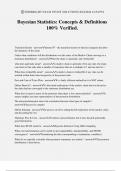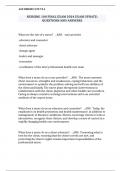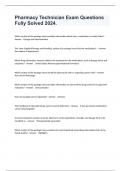Thank you for buying this summary. It includes all the chapters of Smed et al., 12 articles and notes. Note
that the summaries of the articles only cover information that is not covered in the lectures. Otherwise, it
is summarized in the lecture parts. Check Lecture / concept list (click) for a table with concepts!
CONTENT
Week 1................................................................................................................................................ 2
Lecture......................................................................................................................................................... 2
Reading: Smed et al – chapter 1.................................................................................................................. 3
Reading: Smed et al. - Chapter 2 ................................................................................................................. 5
Reading: Smed et al. - Chapter 6 ................................................................................................................. 7
Reading: Kinnebrock & Bilandzic ................................................................................................................. 8
Week 2.............................................................................................................................................. 11
Lecture....................................................................................................................................................... 11
READING: SMED ET AL – chapter 3 ................................................................................................................. 13
Reading: Smed et al. - Chapter 4 ............................................................................................................... 13
Reading: Neitzel ........................................................................................................................................ 15
Reading: Lentz & Pander maat .................................................................................................................. 16
Week 3.............................................................................................................................................. 17
Lecture....................................................................................................................................................... 17
Reading: Bilandzic & Busselle .................................................................................................................... 18
Reading: Green & Jenkins.......................................................................................................................... 21
Week 4.............................................................................................................................................. 24
Lecture....................................................................................................................................................... 24
Reading: Smed et al – Chapter 5 ............................................................................................................... 27
Reading: Busselle & Bilandzic .................................................................................................................... 30
Reading: Roth & Koenitz ........................................................................................................................... 31
Week 5.............................................................................................................................................. 32
Lecture....................................................................................................................................................... 32
Reading: Moyer-Gusé ................................................................................................................................ 35
Reading: Baldwin & Ching ......................................................................................................................... 35
Reading: Duijn & Koenitz ........................................................................................................................... 36
Week 6.............................................................................................................................................. 37
Lecture....................................................................................................................................................... 37
Reading: Barkun ........................................................................................................................................ 40
Reading: Dahlstrom & HO ......................................................................................................................... 40
Week 7.............................................................................................................................................. 42
Lecture....................................................................................................................................................... 43
Reading: Smed et al. – Chapter 7 .............................................................................................................. 42
, 2
WEEK 1
Introduction / Defining Storytelling and Narratives
LECTURE
History of narratives
There are all kinds of definitions for narratives. The definitions are based on very old ideas about
narratives. Each work is explained in more detail here: Reading: Smed et al. - Chapter 2 (click).
• Aristotle’s Poetica: talked about dramatic structures in tragedies and comedies.
• Plato’s De Re Publica: distinguished two fundamental modes of speech (showing vs telling):
o Mimesis. This means imitation and is about letting the characters of a narrative speak.
o Diegesis. This means narration and is about letting a narrator tell what the characters
want to say or think.
• Russian formalism: Russian school that saw new structures in narratives.
• Narratology including French structuralism: a new discipline that studies narrative principles and
representations.
A definition
For this course, we use a two-fold definition of narratives that is based on French structuralism (hence the
French concepts). Narratives consist of:
1) A story (l’histoire)
This is “what” is told. A story always has a story plot which is the sequence of events on a
timeline. It is also called the event structure. An event is a change of state (i.e. something is
happening). A plot event is a narrative turn (i.e. something is happening that drastically changes
the plot of the story).
2) A discourse (la récit) A narrative
This is “how” the what is told (i.e. the Story Discourse
representation of the story). The discourse has What How
always a discourse structure. This is the order Event structure Discourse structure
of the narrated events (e.g. chronological, Sequence of events The order of the events
flashbacks).
Event structures
Labov and Waletzky (1967) divided stories in six phases.
1. Orientation. Who/what/where/when is the story(world)?
2. Complicating actions. A sequence of unfolding events move the story forward.
3. Critical events. A tellable event happens that is central to the story.
4. Resolution. The outcome of the story is presented.
5. Evaluation. Comments on the significance and meaning of the events are given (i.e. the take-
home message).
6. Coda. The transition to the here and now.
We will zoom into phase 3 and 5 as they are two very important phases.
• Phase 3: Critical events
Phase 3 consists of a tellable event. A tellable event is a critical event in the story structure that
makes the story worth telling and worthy of the audience’s attention. It is something
extraordinary, remarkable, unexpected and wonderful.
• Phase 5: Evaluation
During the evaluation phase, the narrator comments on the significance and meaning of the
events. It gives away the take-home message.
Marit Kamp © Summary
, 3
Discourse structures
Discourse structures can evoke emotions such as:
• Suspense. This feeling is evoked by presenting the events in a chronological order but with the
omission of the ending.
• Surprise. This feeling is evoked by presenting the events in a chronological order but with the
omission of an in-between event.
• Curiosity. This feeling is evoked by presenting only the ending.
Narrative elements
Besides the discourse and event structures, narratives consist of typical narrative elements such as
characters, narrators, focalization and kernels/satellites.
• Characters
There are two types of characters:
o Flat character. A character that has only one distinctive characteristic and cannot change
or differ from this characteristic.
o Round character. A character that has more characteristics and is capable of change.
• Narrator
There are two types of narrators:
o Intradiegetic narrator. Here the narrator is a character.
o Extradiegetic narrator. Here the narrator is not a character, but a voice outside of the
story.
• Focalization
This is from whose eyes you perceive the story. There are three types of focalization:
o Zero focalization. The narrator knows more than the character does (i.e. an extradiegetic
narrator).
o Internal focalization. The narrator is the character and, therefore, knows exactly the
same as the character. This type of focalization makes use of invasion. The narrator
knows about the thoughts and feelings of the character (i.e. intradiegetic narrator +
getting to know the character).
o External focalization. Character knows more than the narrator. The narrator only sees
what we see but cannot know the thoughts and feelings of the character.
• Kernels vs. satellites
Events of a story function either as a kernel or as a satellite.
o Kernels. The essential content of the story that is repeated when it is experienced anew.
The kernels form the identity of the story. It cannot be altered or omitted.
o Satellites. The content that could be omitted or altered without changing the identity of
the story.
READING: SMED ET AL – CHAPTER 1
Interactive storytelling is including an active participant that is an agent in the story world. The following
model explains this process of interactive storytelling in an ideal situation. The model is called the
“Spectrum of interactivity”.
Marit Kamp © Summary
, 4
Interactive storytelling
This model also shows that not only interactive storytelling is interactive, but all types of storytelling are
somewhat interactive. In conventional storytelling (left side of the model) the interactor interacts with the
product, but the interactor cannot control what is made. Instead, the designer has total control of
everything that happens. In a book, for example, the reader reads the text from the start to the end of the
book. On the other hand, in simulations (right side of the model), for example in a live-action role-playing
game, the interactors have total control of the content of the story. There is no designer, but only active
interactors.
However, when referring to interactive storytelling itself, people are referring to the middle part
of the model. The difference between conventional and interactive storytelling is that in conventional
storytelling the designer is the one that has a key role in deciding what is going to happen and in
interactive storytelling the interactor is the one who decides this. In interactive storytelling the designer
provides elements, but the interactor decides what he is going to do with it.
Partakers
So, there are two partakers in interactive storytelling: the designer and the interactor. The designer is
referred to by Janet Murray as the cyberbard. She sees the designer as a narrative architect. He/she has
certain mechanics in mind for his interaction. These mechanics require a certain platform. Together with
the system of the platform and the content, the designer has in mind a story world is born. If the
interactor agrees with this story world, he is able to interact with it. This interaction between partakers is
summarized in the figure below.
Narrative, plot and story
The story world consists of several elements.
- Narrative. An unchangeable material presented to the interactor.
- Event. Any event that the computer can demonstrate. There are different types of events:
o Narrated event. An unchangeable event that the computer can demonstrate.
o Computer-generated event. A result of processing done the underlying platform.
o Player-generated event. A response to the interactor’s input.
o Plot event. An event that is dramatically significant.
Interaction
Interaction is a reciprocal action where entities’ actions influence one another. The interactive range of
software is the freedom of the software: how many choices can the interactor make? This should not be
confused with the agency of the interactor as this is the interactor’s ability to influence the system. The
interactor can have the ability to make many choices, but if they are not meaningful, the interactor has
little agency. There are three factors that influence the interactivity of storytelling.
- Speed. The faster the interaction, the better the possibilities for interaction.
- Depth. The more human-like the interaction, the better the interaction.
- Choice. The better the interactive range and agency of the interactor, the better the interaction.
Marit Kamp © Summary
, 5
READING: SMED ET AL. - CHAPTER 2
This chapter presents a selection of research done in analyzing stories in general and interactive stories in
particular.
Analysis of storytelling
Aristotle’s Poetics (384-322 BCE)
This work formed the basis of Western literary theory, even though it is based on ancient Greek theatre.
Only the part about tragedies has survived. Aristotle recognizes six elements of tragedy:
- Plot (mythos): the incidents that happen after one another. It is a causal construction.
- Character (ethos): the moral choices that the characters make.
- Thought (dianoia): the reasoning of the characters.
- Language (lexis): the use of language.
- Melody (melos): the language, rhythm and melody of speech.
- Spectacle (opsis): the whole appearance.
Moreover, Aristotle recognizes two narrative forms in which this tragedy can be told:
- Epic. The events are represented through verbal narration (i.e. diegesis).
- Dramatic. The events are represented through the imitation of action (i.e. mimesis).
For Aristotle, a change (metabasis) in the plot is an important element of any tragedy. This theory on
metabasis is summarized in the so-called dramatic arc (see below). The plot can change due to reversal (a
turning point in the plot) or recognition (a change from not-knowing to knowing).
A modern view on this arc is Freytag’s pyramid (see below).
Marit Kamp © Summary
, 6
Vladimir Propp’s morphology (1895-1970)
In the 1920s Russian formalism arose, which was a new school viewing the structure of stories. Russian
formalism divided the story into three layers:
1. Fabula. The logically and chronologically related events within a causal construction.
2. Sjužet. The finished arrangement of narrated events as they are presented to the reader.
3. (Media/text. The expression of the plot in language signs).
Vladimir Propp was influenced by Russian formalism. He divided stories into four phases:
1. Introduction. It introduces the situation and most of the main characters and sets the scene for
the subsequent scene (exposition in Freytag’s pyramid).
2. Body of the story. The main story starts here and extends to the departure of the hero on the
main quest.
3. Donor sequence. The hero goes in search of a method by which the solution may be reached.
4. Hero’s return. The hero returns home, possibly facing a final task.
Moreover, Propp defines several character roles within this structure.
Joseph Campbell and the hero’s journey (1904-1987)
Campbell believes that all stories derive from one great story. For this great story, he outlined a cycle of 3
phases including 17 stages of a hero’s journey.
Research on interactive storytelling
Research on interactive storytelling began in 1986 when Brenda Laurel published her dissertation. She
compares computers with theatre. A couple of years later, Janet Murray did the same but compared
computers to literature. This initiated a debate on the possibility to analyze games with narrative theories.
Brenda Laurel and interactive drama
Laurel used the same categories as Aristotle but changed some names of the categories.
- Plot → Action: the incidents that happen after one another. It is a
causal construction.
- Character: the moral choices that the characters make.
- Thought: the reasoning of the characters.
- Language: the use of language.
- Melody → Pattern: the language, rhythm and melody of speech.
- Spectacle → Enactment: the whole appearance.
Each level is connected to one another via two causal chains (see right-side).
Moreover, Laurel believes that the choices in a story become fewer as you progress through the story.
She calls this model the flying wedge of possibilities (see below).
Marit Kamp © Summary










